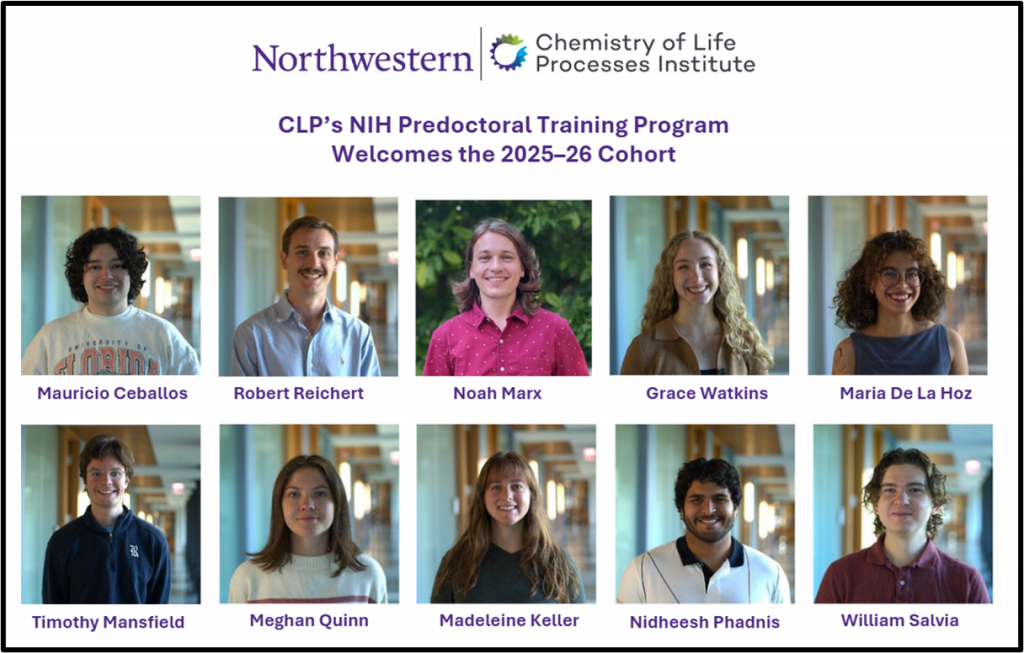
Join us in welcoming Chemistry of Life Processes Institute’s exceptional group of graduate students supported by the NIH-funded Chemistry of Life Processes Predoctoral Training Program. Each year, through an intensive application process, The Institute brings students together across Northwestern to pursue cutting-edge research at the interface of chemistry and biology.
We are excited to welcome an impressive cohort of 10 predoctoral trainees, representing both new and returning scholars in the program. Their projects span topics from cancer immunology and protein conjugation to novel biomaterials and therapeutic design.
To introduce this year’s cohort, we asked each trainee to share a bit about their research, why they chose the CLP Training Program, and their goals for the future.
Returning Trainees
These students have successfully reapplied for their second year in the program and continue to advance their research while deepening their transdisciplinary training.
Mauricio Ceballos
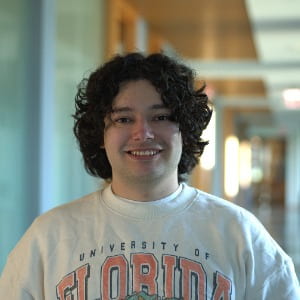
Graduate Program: Materials Science and Engineering
Preceptors: Derk Joester (Materials Science and Engineering) and Marco Gallio (Neurobiology)
What is the focus of your training grant research project?
We study antifreeze proteins from the snowfly, an insect that thrives in extreme cold. I’ve cloned and purified these proteins to see how they slow ice formation, and we’re now testing engineered variants to control other crystals with potential applications in drug development and biomaterials.
What appealed to you most about the CLP Graduate Training Program?
Being part of a collaborative community has been invaluable. I’ve learned to better communicate with chemists and biologists, and CLP has offered opportunities to grow through networking, mentoring, and teaching.
What are your plans after graduation?
I see myself working in industry or a national lab, applying fundamental science to practical problems while building leadership and communication skills.
Noah Marx

Graduate Program: Biological Sciences
Preceptors: Deyu Fang (Pathology) and Xiaoyu Zhang (Chemistry)
What is the focus of your training grant research project?
We are developing compounds to degrade FoxP3, a key protein that enables regulatory T cells to suppress immune responses in tumors. I’ve tested PROTAC molecules in Tregs, and next we’ll optimize them and explore in vivo delivery with antibody-coated lipid nanoparticles.
What appealed to you most about the CLP Graduate Training Program?
CLP’s interdisciplinary culture has been invaluable. I’ve benefited from chemists’ insights and grown as a communicator through journal clubs, presentations, and cross-field discussions.
What are your plans after graduation?
My goal is to lead cancer immunology drug development projects in academia or industry, building skills in writing, presenting, and networking to prepare for that role.
Robert Reichert
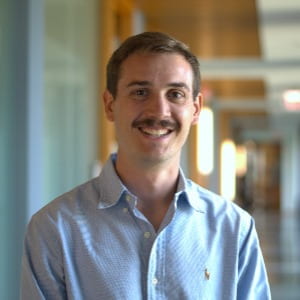
Graduate Program: Biomedical Engineering Preceptors: Lisa Volpatti (Biomedical Engineering) and Tom Meade (Chemistry)
What is the focus of your training grant research project?
We are developing a non-viral, polymer-based gene delivery platform. Our lead candidate, PP-SDP, shows promising transfection efficiency. I’m optimizing performance, monitoring real-time efficacy with MRI, and adding tumor-specific targeting through melanoma antibody fragments.
What appealed to you most about the CLP Graduate Training Program?
CLP bridges chemistry, biology, and engineering. The dual-mentor model has been critical, and I value being part of a community that celebrates translational science and entrepreneurship.
What are your plans after graduation?
I plan to work in biotechnology with the long-term goal of starting a company that translates lab discoveries into therapies.
Grace Watkins
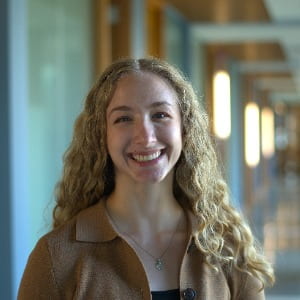
Graduate Program: Chemistry Preceptors: Milan Mrksich (Biomedical Engineering) and Neil Kelleher (Chemistry)
What is the focus of your training grant research project?
My research builds on advancing the MegaMolecule platform with miniCrabTag, a reduced-weight linker system. I’ve been assembling and testing constructs with biological assays and mass spectrometry, and working with the Kelleher lab on computational modeling to better understand protein interactions.
What appealed to you most about the CLP Graduate Training Program?
CLP’s emphasis on collaboration across chemistry and biology fits my research perfectly. I’ve refined my communication skills, connected with peers across disciplines, and grown through professional development workshops.
What are your plans after graduation?
I hope to pursue an academic career combining research and teaching, while publishing, presenting, and mentoring the next generation of scientists.
New Trainees (Appointed 2025)
Six new trainees join CLP this year, each bringing unique perspectives and innovative projects.
Maria De La Hoz
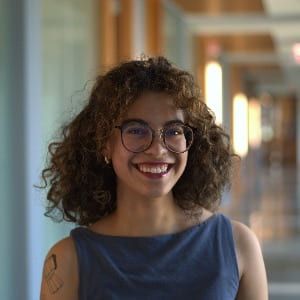
Graduate Program: Chemistry Preceptors: Amy Rosenzweig (Chemistry/Molecular Biosciences) and Brian Hoffman (Chemistry/Molecular Biosciences)
What is the focus of your training grant research project?
My project investigates the structure and function of CopCD, a bacterial membrane protein that likely imports copper into the cytoplasm. Using bioinformatics, in vivo transport assays, biochemical purification, and EPR spectroscopy, I aim to clarify how CopCD binds and moves copper. This work could shed light on bacterial copper management and inform antibiotic strategies.
What appealed to you most about the CLP Graduate Training Program?
I was drawn to CLP’s strong culture of interdisciplinary collaboration. It allows me to connect my background in inorganic chemistry with my growing interest in biology, while learning from mentors and peers with diverse expertise.
What are your plans after graduation?
I aspire to an academic career that combines research and teaching, while mentoring students and promoting equity in STEM.
Meghan Quinn
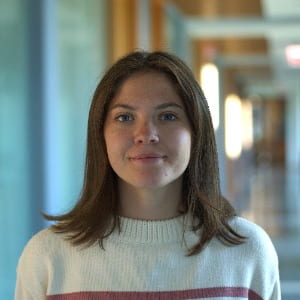
Graduate Program: Biomedical Engineering
Preceptors: Colin Hisey (Biomedical Engineering) and William Klein (Neurobiology)
What is the focus of your training grant research project?
We study how neural network structure influences the production and cargo of extracellular vesicles (EVs). Using micropatterning, I create organized neuron cultures to examine EV communication in healthy and disease-like conditions, with implications for Alzheimer’s and traumatic brain injury.
What appealed to you most about the CLP Graduate Training Program?
I was drawn to CLP’s emphasis on multidisciplinary collaboration. My work spans engineering, neuroscience, and translational medicine, and the program provides opportunities to learn new techniques, get feedback, and strengthen communication skills.
What are your plans after graduation?
I plan to pursue a career in industry-leading projects that engineer EVs as diagnostics and treatments for brain diseases, while staying active in publishing and professional societies.
Timothy “Timmy” Mansfield
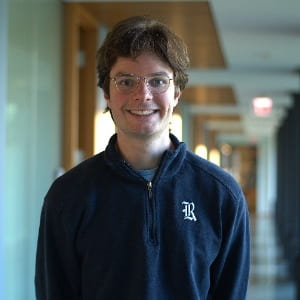
Graduate Program: Chemistry
Preceptors: Milan Mrksich (Chemistry/Biomedical Engineering) and Leonidas Platanias (Medicine, Robert H. Lurie Comprehensive Cancer Center)
What is the focus of your training grant research project?
My project applies the MegaMolecule platform to develop siRNA conjugates for glioblastoma therapy. By combining fusion proteins with synthetic linkers, I build protein–RNA conjugates that carry therapeutic siRNAs. In partnership with the Platanias lab, we’re testing these constructs against SLFN5 and exploring antibody fragments to direct them across the blood–brain barrier.
What appealed to you most about the CLP Graduate Training Program?
As a chemist moving into chemical biology, I was drawn to CLP’s interdisciplinary training. The program gives me access to in vivo models and a community that helps me communicate more effectively across fields.
What are your plans after graduation?
I’m still exploring where my career will take me, but I want to work at the chemistry–biology interface on projects with translational impact. I’m focused on building strong writing and presentation skills along the way.
Nidheesh Phadnis
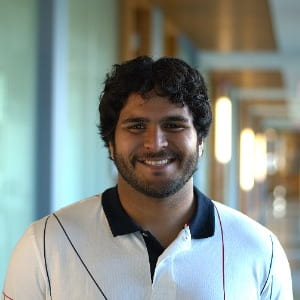
Graduate Program: Chemistry
Preceptors: Karl A. Scheidt (Chemistry) and Daniela Matei (Obstetrics and Gynecology, Feinberg School of Medicine)
What is the focus of your training grant research project?
My project is focused on the total synthesis and biological evaluation of repin, a natural product with selective cytotoxicity in ovarian cancer cells. In the Scheidt lab, I synthesize repin and analogs to probe structure–activity relationships, while in the Matei lab we study their impact on cancer models. This work aims to expand targeted protein degradation strategies and clarify DCAF2’s role in therapy resistance.
What appealed to you most about the CLP Graduate Training Program?
I was drawn to CLP for its interdisciplinary training, pairing my synthetic chemistry expertise with biological assays and translational perspectives. The program’s collaborative community enriches my research and communication skills.
What are your plans after graduation?
I plan to pursue a career in the pharmaceutical industry focused on small-molecule therapeutics, while continuing to mentor and teach.
Madeleine Keller
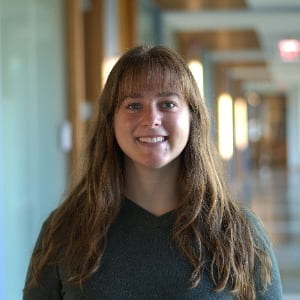
Graduate Program: Chemical and Biological Engineering
Preceptors: Josh Leonard (Chemical and Biological Engineering) and Colin Hisey (Biomedical Engineering)
What is the focus of your training grant research project?
We are developing a micropatterning platform to study how cell migration and communication affect extracellular vesicle (EV) uptake and delivery. By combining surface chemistry, microfabrication, and synthetic biology, I aim to build customizable surfaces that clarify EV dynamics and advance their therapeutic applications.
What appealed to you most about the CLP Graduate Training Program?
I was excited to join CLP for its interdisciplinary research culture. The dual-mentor model connects material science with biology, while seminars and forums provide opportunities to strengthen technical and communication skills.
What are your plans after graduation?
I plan to pursue a career in cell and gene therapy, moving ideas from academic labs into biotech where they can become real-world tools and treatments. Long term, I hope to lead collaborative teams tackling challenges in therapeutic design.
William “Will” Salvia
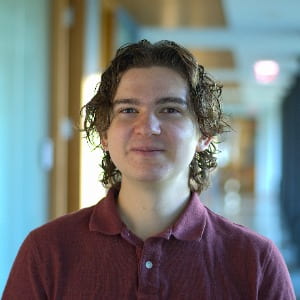
Graduate Program: Chemistry
Preceptors: Songi Han (Chemistry) and Fred Turek (Neurobiology)
What is the focus of your training grant research project?
We are studying Light-Oxygen-Voltage (LOV) proteins in the gut microbiome to understand how they sense and respond to environmental cues such as light, oxygen, gravity, and magnetic fields. My project combines magnetic resonance, spectroscopy, and informatics to explore how these proteins influence circadian biology and gut health. By modeling key LOV variants and analyzing NASA’s GeneLab data, we aim to uncover how microbial proteins respond to environmental changes on Earth and in Space.
What appealed to you most about the CLP Graduate Training Program?
I was drawn to CLP because it fosters collaboration across disciplines that don’t often meet. My work benefits enormously from the dual-mentor structure. CLP also provides a platform for feedback, networking, and shared learning with peers approaching problems from very different perspectives.
What are your plans after graduation?
After my Ph.D. I want to continue my research in either industry or academia, combining chemical tools with biological questions to better understand how organisms respond to their environments. Alongside research, I’m motivated to mentor students and build collaborations that link physical science approaches to life sciences.
Looking Ahead
This year’s CLP trainees embody the spirit of innovation and collaboration that defines the Chemistry of Life Processes Institute. Their projects not only push the boundaries of research but also pave the way for new therapeutic strategies, scientific insights, and career pathways.
Please join us in congratulating and welcoming the 2025–2026 CLP predoctoral trainee cohort. We look forward to following their progress in the years ahead!
by Sara Olson

